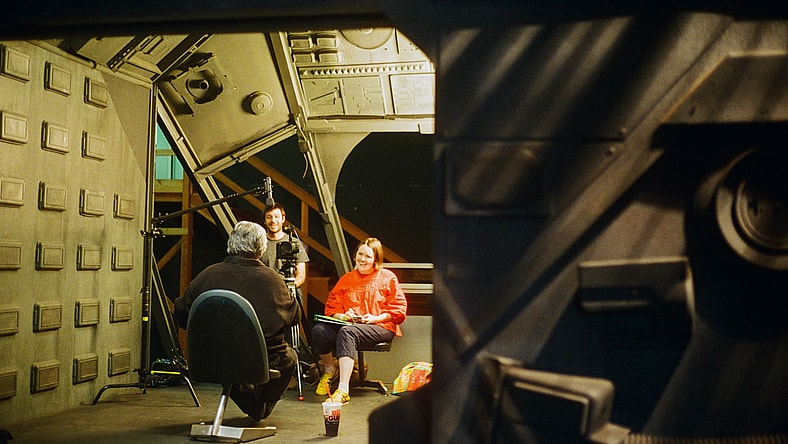
As a lifelong movie lover, Anna Quinlan grew up loving the Wilhelm Scream without knowing it had a name.
The scream — which you can hear here — has appeared in countless films, including repeatedly in the Star Wars and Indiana Jones movies. It was first recorded for a 1951 Gary Cooper film called Distant Drums, and was then reused throughout the 1950s. Two decades later, a cohort of sound designers began gleefully sneaking it into films big and small.
But when Anna Quinlan watched movies as a kid, she didn’t know the scream’s history. She just knew that it seemed to pop up everywhere.
“I first noticed the Wilhelm Scream sound effect growing up watching movies, but I didn’t know it had a name. It wasn’t until college that I heard the James Blake song ‘The Wilhelm Scream’ and I Googled the track title and found out that it was named after the famous sound effect,” she told MovieMaker.
“For many years I would hear it and just smile to myself, until one day I heard it in an old episode of Survivor and it really made me laugh. It occurred to me that there’s just a bunch of sound designers throwing the scream in places and having a laugh about it, and I suddenly had this burning desire to talk to them.”
When it came time to make her own film, she knew she wanted to focus on cinema’s most beloved cry of anguish. Her short documentary “The Wilhelm Screen” is a tight, relentlessly entertaining that played this week at Indianapolis’ Indy Shorts film festival, one of our 50 Film Festivals Worth the Entry Fee and 25 Coolest Film Festivals in the World.
We talked with Quinlan about making her first film, definitively determining who provided the vocals on the Wilhelm Scream, and how another film festival, Birmingham’s Sidewalk Film Festival, started her on her filmmaking career.
MovieMaker: How did you become a filmmaker, and what led to your interest in the Wilhelm Scream?
Anna Quinlan: I grew up in Birmingham, Alabama in the ‘90s and I got fixated on movies at a very young age. It was such a fun time because home video was still relatively new and it was possible to watch the same movie over and over again and memorize it. I got a camcorder and some very basic editing software when I was around 13, so I started making little movies.
I was very lucky to grow up in Birmingham because the Sidewalk Film Festival is based there and I started competing in their Teen Filmmaking Competition. I won the competition during my senior year of high school and that gave me a huge amount of confidence. I enrolled in the Film Studies program at Sarah Lawrence College, which brought me up to New York, and I’ve been working in the film & video industry here ever since!
MovieMaker: How did the Wilhelm Scream get its kind-of inaccurate name?
Anna Quinlan: The Wilhelm Scream got its name from Ben Burtt (Star Wars) and Richard Anderson (Raiders of the Lost Ark), the two legendary sound designers who first started using it as an inside joke while they were film students at USC back in the 1970s. Ben was a major sound nerd his whole life and used to record movie soundtracks with a tape recorder as a kid. USC had been donated the Warner Brothers sound library, so Ben went looking for a “man screaming” sound effect that he’d heard in westerns growing up.
At the time, he thought that its first use was in a Western called The Charge at Feather River from 1953. In the film there’s a character named “Private Wilhelm” who lets out the scream when he’s hit by an arrow in the leg. Later, Ben discovered that the actual first appearance of the scream was in Distant Drums, a western from 1951, and that the original sound library name of the scream was “Man eaten by alligator”.
MovieMaker: Why do you think the sound of this scream elicits such a warm feeling from so many people?
Anna Quinlen: While I was researching the scream I reached out to a few avid Wilhelm Scream fans that I found online. I connected with one, Jeremy, who is a postal worker in West Virginia and runs a Wilhelm Scream fan page on Facebook. I asked him how the Wilhelm Scream makes him feel when he hears it in a movie or show and he said that it feels like “coming home.” I thought that was such a beautiful way to put it and I feel exactly the same way.
I think the Wilhelm Scream symbolizes an earnest reverence for the way that movies make us feel. Richard Anderson talks about it in the film when he says that he and Ben Burtt were fans of the “having fun” kind of movies. Movies are a form of escape and adventure that’s so desperately needed, especially in scary times. The Wilhelm Scream is like an ancient talisman from the origin point of adventure movies. It’s human, it’s emotional, it’s guttural, it transcends language and time. There’s something foundational about it, like a monument we all keep coming back to visit as the years go by.
Anna Quinlan on the Wilhelm Scream and “Purple People Eater” Connection

MovieMaker: You track down an expert who determines, unequivocally, that the Wilhelm Scream came from actor Sheb Wooley, best known for the song “The Purple People Eater.” Was there much debate? As you note in your film, editor Steve Lee has been saying this on his site, Hollywood Lost and Found, for years. Did anyone disagree with him?
Anna Quinlan: No one had offered up alternate identities for the “screamer,” but it was frustrating to not be able to definitively confirm it was Sheb Wooley. I actually got the idea to track down a vocal forensics expert because Steve had mentioned that we’d never know for sure unless the audio could be analyzed somehow.
I’d spoken with Sheb’s daughter, Chrystie Wooley, who said that she could hear her dad’s voice in the scream, but she didn’t know for sure if it was him. I thought it would be so exciting to get that confirmation, both for the Wilhelm Scream fans as well as for Sheb’s family and friends. Chrystie was thrilled to find out the definitive answer!
MovieMaker: Was Sheb Wooley aware in his lifetime that his one-off scream from Distant Drums was used in so many films?
Anna Quinlan: Sadly, we’ll never know for sure! Sheb passed away in 2003, right around the time that Ben Burtt tracked his name down in the Warner Brothers archives, so no one’s been able to ask him properly. That being said, his family has said that he once mentioned enjoying providing his voice for movies, specifically including screams!
MovieMaker: I hate to be so legalistic, but are there royalty payments involved when using the scream in a film?
Anna Quinlan: This is actually the most common question I’ve gotten about the film. The scream was originally recorded by Warner Brothers, but then Warner Brothers donated its sound library to the Cinema Studies program at USC (where Richard and Ben got into it), so the technical “ownership” of the sound has always been fluid. At this point it’s unofficial public domain. I do think that sound effects should be protected IP because the artists who make them deserve ownership of their work. That being said, I’m grateful the scream has been able to live such a widespread life.
MovieMaker: What was the biggest challenge of making this film, and how did you overcome it?
Anna Quinlan: “The Wilhelm Scream” is my directorial debut, so the biggest challenge for me was my own imposter syndrome as a filmmaker. I’d spent my life waiting for someone to tap me on the shoulder and tell me, “It’s time to make your own film!” I had to realize that no one was going to push me to do that and that I had to just get that ball rolling on my own.
Throughout the process it was hugely important to me to approach everything with humility and openness. I knew that I was venturing into a world that I wasn’t a part of. The history of the scream lives with these legendary sound designers, all of whom I have massive respect for. It was very important to me to connect with Ben Burtt directly so that I could make it known that I was approaching this topic with respect and genuine curiosity, because I knew that the story of the scream had been mangled in the past.
While Ben didn’t participate in the film itself, he was very kind and supportive from behind the scenes. He likened the pursuit of sound effects history to exploring ancient Egyptian tombs, which is an analogy that I absolutely love. In the process of researching the film, I spoke with the Mount Rushmore of movie sound: Ben, Richard, Mark Mangini, Randy Thom, Gary Rydstrom, Ron Bartlett… It was incredible.
The person who truly helped me overcome my fears the most was Steve Lee, who remains my close friend to this day. He saw that I was serious about this film and that I authentically love the work that he and his colleagues do. I couldn’t have made this film without him.
Main image: Anna Quinlan conducts an interview for “The Wilhelm Scream.” Photo by Ian Pritchard.
